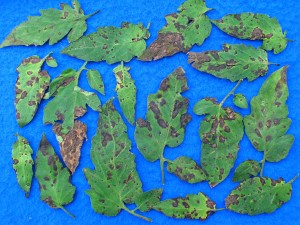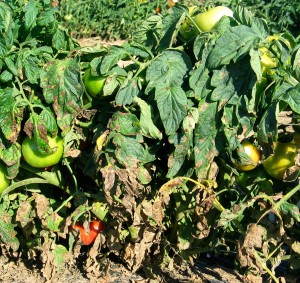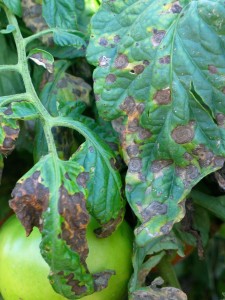Early Blight in Tomatoes
Early Blight in Tomatoes
Last week I talked about blossom end rot in tomatoes. This week I will discuss another common issue that causes problems in our tomato patches in east Idaho- Early Blight.
Early Blight is probably the most common disease found in tomato plants in east Idaho. Although it can infect all parts of the plant including stems and fruit, the first visible symptoms are in the leaves. The lower leaves are usually the first affected, then the infection slowly moves up the plant as the season progresses. Irregular brown spots, often surrounded by a yellow halo, become more numerous as the infection increases. A mature early blight lesion has a target-like bulls-eye  appearance. Severely infested leaves may completely die and fall off. Sunken lesions on the stems may also appear.Early blight weakens tomato plants but seldom kills them. However, it can severely reduce the quantity and quality of your harvest.
appearance. Severely infested leaves may completely die and fall off. Sunken lesions on the stems may also appear.Early blight weakens tomato plants but seldom kills them. However, it can severely reduce the quantity and quality of your harvest.
The causal agent (culprit) is Alternaria solani and it needs temperatures of 75-85F and humid conditions to infect the plant. So avoid watering the leaves of the plant, especially at night, as free water on leaves can result in spore germination in less than one hour at temperatures above 80F. Spores are spread by wind and splashing water- another reason to avoid watering the foliage of the plants. It only takes about 5 to 7 days from infection until you see visible symptoms.
Prevention and control methods include the following:
- Prune out infected leaves as they appear.
- Avoid overhead irrigation if possible, or irrigate during the day when leaves will remain wet for the shortest time possible.
- Space plants further apart to facilitate good airflow.
- Spray with Daconil (Chlorothalonil) every 7 to 14 days at the first sign of spotting on lower leaves, typically in July.
- Remove infected plant material (vine, leaves, and fruit) from the garden in the fall.
Above photos courtesy Cornell University
Additional information:
www.ext.colostate.edu/mg/Gardennotes/718.html
http://utahpests.usu.edu/IPM/htm/vegetables/vegetable-insect-disease/early-blight




